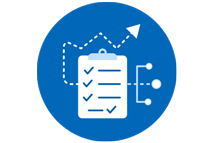

SIGNALS+ NEWSLETTER SUBSCRIPTION
Stay updated and leverage Signals+ latest insights, information and ideas on Connectivity, Digital Health, Electrification, and Smart Industry.
Thank you for subscribing to ADI Signals+. A confirmation email has been sent to your inbox.
You'll soon receive timely updates on all the breakthrough technologies impacting human lives across the globe. Enjoy!
CloseBUILTSPACE: DESIGNING EFFICIENCY AND SUSTAINABILITY INTO SMART BUILDINGS
If you’ve ever swiped a key card to enter a building or walked into a darkened conference room only to have the lights suddenly turn on or felt the temperature in your cubicle change as more people enter your area, you’ve experienced smart buildings at work.
As more employees are returning to offices, commercial building managers see a definitive need to increase the adoption of smart building technology platforms. The technologies that are critical to managing this influx of on-site employees include the regulation of a building’s ventilation system, temperature measuring devices, and space optimization to ensure physical distancing.
What is a Smart Building?Smart buildings leverage Intelligent Edge technologies to integrate IoT-connected devices, augmented reality, visual and motion sensors, and other systems to automate day-to-day processes, including climate control, security, and lighting—all to maximize efficiency and enhance tenant experiences. |

Leading this transition toward smart buildings is BuiltSpace Technologies. BuiltSpace creates digital versions of facilities that enable property managers to measure a building’s operational performance and improve functionality and energy efficiency. They do so by collecting and organizing data from assets (machines) and people’s activities, in real time, across building ecosystems, even down to an individual asset.
For BuiltSpace to contribute to the smart buildings evolution, they first needed a greater understanding of their clients’ critical systems, such as HVAC, to glean actionable data to help them become more efficient. Unfortunately, BuiltSpace encountered many clients who operate older buildings and systems spread across wide areas with extreme environmental and temperature fluctuations, making it difficult to measure the functionality and fault potential of motors within these systems.
BuiltSpace realized that in order to empower building owners and property managers to adhere to strict regulations around sustainability and efficiency, they have to require a system-wide solution that provided remote monitoring capabilities. ADI OtoSense™ Smart Motor Sensor (SMS) was the ideal solution.
AT A GLANCE
ABOUT
BuiltSpace Technologies designs smart buildings by creating digital versions of facilities and then measures, collects, and organizes data from assets and people’s activities, to improve performance, functionality, and energy efficiency.
CHALLENGES
- Large, old buildings with diverse footprints, aging equipment with sound/vibration issues (key indicators of wear/faults)
- Property managers may not have access to equipment in tough-to-reach locations to detect minute issues with machines
- Monitor motors, pumps, and fans not only for wear but for operational efficiency
GOAL
Proactively monitor a building’s critical systems’ motors to enhance safety, efficiency, and profitability.
APPLICATION
ADI OtoSense SMS’ proactive, predictive maintenance from continuous monitoring of ventilation systems.
RESULTS

Improved Operational Reliability

Optimized Allocation of Maintenance Resources

Decreased Unplanned Maintenance

Reduced Costly Downtime
A SMART IDEA: A PARTNERSHIP BUILT ON INTELLIGENCE
When BuiltSpace was deciding on whether to upgrade or enhance its client’s machines in their aging buildings, they found it more cost-effective to use an SMS rather than install almost $500,000 worth of new machine/motor upgrades. Since BuiltSpace knew of the esteemed reputation of Analog Devices and its OtoSense SMS, it was an easy decision.
With ADI OtoSense SMS, BuiltSpace helped clients optimize their systems and safely monitor multiple machines remotely 24/7, while gaining unique visibility and keen insights into motors that may be hazardous to reach physically. All this actionable data can then be tied directly into the buildings’ systems for greater insight.

In one dramatic instance, BuiltSpace actually found one motor needlessly running continuously for 24 hours at 1800 rpm! What’s more, since water damage is one of the costliest maintenance items, BuiltSpace is now considering analytics on the load side of a water pump to monitor for pressure load drops, which indicates leaking. OtoSense SMS is delivering a superior preventative maintenance, peace-of-mind insurance policy, which will pay significant dividends down the road.
ADI OTOSENSE SMS: PREDICTIVE MAINTENANCE TO THE RESCUE
ADI OtoSense Smart Motor Sensor is an AI-based, full turnkey, hardware and software solution for condition-based monitoring. It monitors the condition of electric motors by combining best-in-class sensing technologies with leading-edge, data analysis. ADI OtoSense SMS detects anomalies and defects in the equipment, enabling maintenance engineers to forecast maintenance cycles and avoid unplanned downtime.
Agnostic of motor type, ADI OtoSense SMS covers the most critical diagnostics, translating data into actionable insights. The Smart Motor Sensor allows for 24/7 condition-based monitoring of all low voltage electric motors and presents real-time pertinent information, which can be accessed remotely.

Once BuiltSpace implemented OtoSense SMS, it enabled them to deliver an unprecedented, predictive maintenance strategy and cost-effective, real-time analysis to save on unplanned downtime costs. In addition, BuiltSpace could deliver CapEx savings since purchasing new machinery was not necessary, due to the fact it was adding a predictive maintenance component on top of existing machinery. This is a major benefit for manufacturers since in a recent study 34% cite aging equipment as a main cause of unplanned downtime.1 What’s more, after a predictive maintenance solution is implemented, breakdowns had been reduced by 70%.2
One thing of note, OtoSense SMS does not replace machine domain experts. Rather, OtoSense leverages their years of expertise and insight into mechanical motors as they work side-by-side with OtoSense to recognize and categorize problems early on, enhancing motor efficiency and productivity.

“Most predictive analytics solutions in the facilities industry depend on integration with building automation systems. ADI OtoSense SMS lets building owners inexpensively, remotely monitor critical motors without expensive wiring and system integration, and often when no BAS exists.”Rick Rolston
President and Founder | BuiltSpace Technologies
REACTIVE VS. PREDICTIVE MAINTENANCE: NO COMPARISON
 Reactive MaintenanceReactive maintenance takes place after a problem has occurred, costing companies thousands in repair costs and lost production time. |
 Predictive MaintenancePlanned/preventive maintenance occurs before a problem presents itself, which increases the longevity of the equipment and a company’s bottom line. |
|
800 hrs /yearAverage downtime for manufacturers3 |
+10% to 20%equipment uptime2 |
|
$532K /hrCost of unplanned downtime4 |
5% to 10%Reduced maintenance costs2 |
|
10xCost of unplanned downtime vs. scheduled3 |
25%Increased productivity2 |
PREDICTIVE MAINTENANCE HELPS SMART BUILDINGS STAY SMART

Ultimately, with many companies focusing on energy efficiency, employee safety, and satisfaction, as well as the goal of net-zero carbon emissions, owners of commercial real estate will need to adopt smart building technologies sooner rather than later. BuiltSpace has shown there is demonstrative proof that smart buildings add exponentially to a company’s bottom line in terms of energy savings—which helps sustainability efforts and employee on-site satisfaction.
But for smart buildings to continually function properly and to perform at their fullest potential, a predictive maintenance strategy—featuring a smart motor sensor—must be leveraged to deliver real-time, actionable results. In other words, a predictive maintenance strategy helps smart buildings remain true to their name.
Resources
135 Latest Maintenance Statistics for 2022: Data, Adoption & Strategies - Financesonline.com
2Deloitte Predictive-Maintenance PositionPaper (PDF)
3Cost of Industrial Downtime: 20 Mind-Boggling Stats | BehrTech Blog
4Equipment Failure Is Costly for Manufacturers | 2021-07-16 | ASSEMBLY (assemblymag.com)



